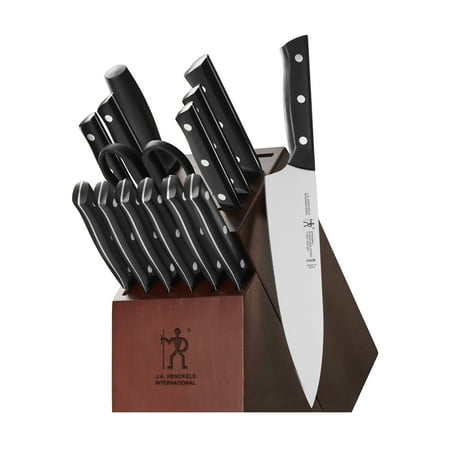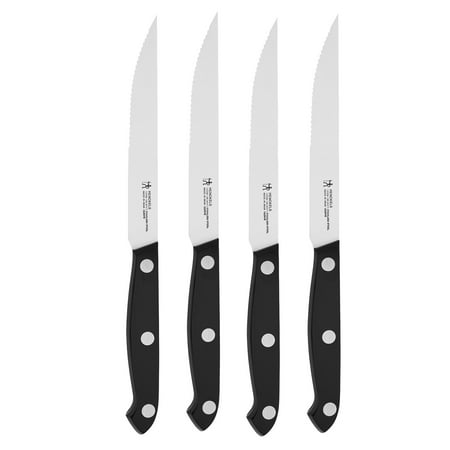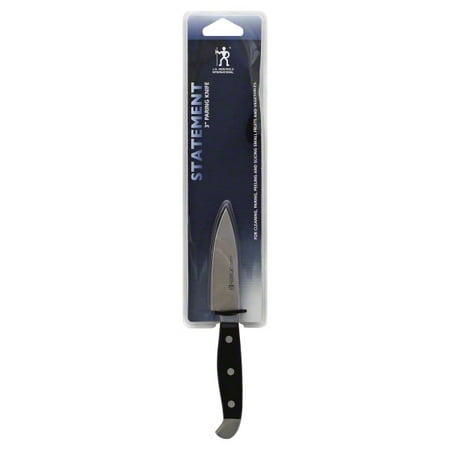Zwilling J.A. Henckels is a German company that manufactures knives,...
Read More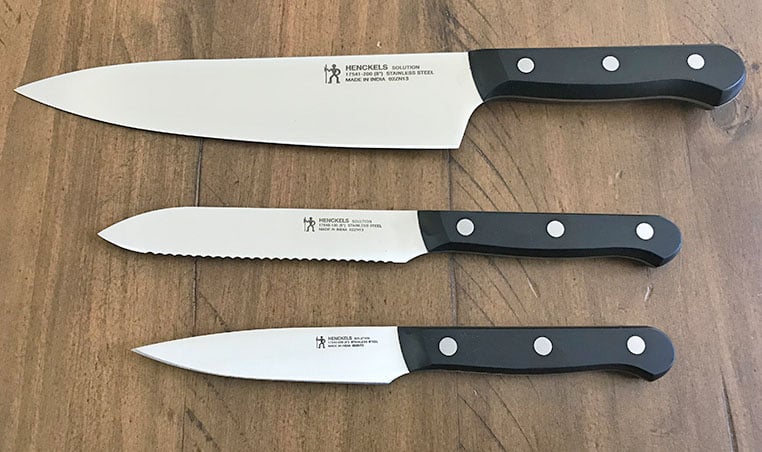
Henckels is a renowned and historic brand in the world of cutlery, known for producing high-quality knives and kitchen tools. The brand’s full name is “Zwilling J.A. Henckels,” with “Zwilling” meaning “twin” in German, referring to the founder’s last name and the twin symbol that has become synonymous with their logo.
Founded in 1731 in Solingen, Germany, by Johann Abraham Henckels, the company has a rich tradition of craftsmanship and innovation in the production of knives. Henckels knives are celebrated for their precision, durability, and balance, making them a preferred choice among both professional chefs and home cooks.
Henckels offers a wide range of knives crafted from various materials, including stainless steel and high-carbon steel. Their product lines often include different series, each catering to specific needs and preferences. These series can vary in terms of blade design, handle material, and overall construction.
Notable lines within the Henckels brand include the Four Star, Pro “S,” Twin Signature, and Professional “S” series. They also offer knife sets, individual knives, and other kitchen accessories, providing options for various culinary tasks and skill levels.
Over the centuries, Henckels has maintained a commitment to quality and innovation, combining traditional craftsmanship with modern technology to create knives that excel in performance and longevity. The brand’s reputation and expertise have solidified its position as a respected leader in the world of cutlery.
Type of Henckels knife
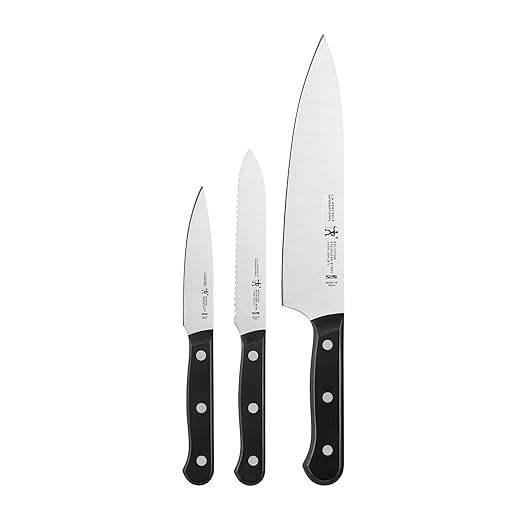









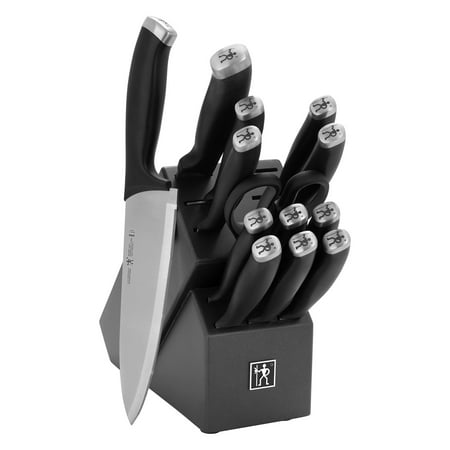
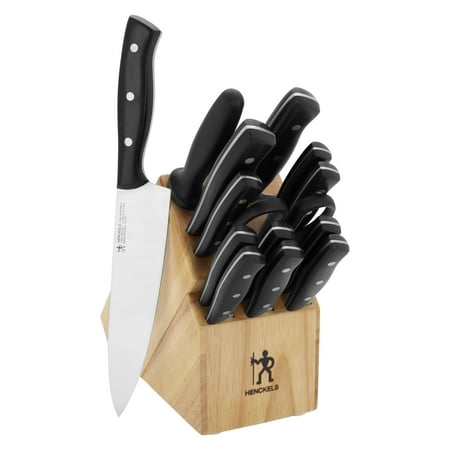

Henckels offers a wide variety of knife types within their different knife lines, each designed for specific tasks in the kitchen. Here are some common types of Henckels knives and their purposes:
- Chef’s Knife: Also known as a cook’s knife, this versatile knife is a kitchen workhorse. It’s used for chopping, slicing, dicing, and general food preparation tasks.
- Paring Knife: A small, versatile knife with a short blade used for intricate tasks like peeling, trimming, and cutting small fruits and vegetables.
- Utility Knife: Slightly larger than a paring knife, it’s suitable for tasks that fall between those of a chef’s knife and a paring knife. It’s great for slicing small to medium-sized items.
- Santoku Knife: A Japanese-style knife with a shorter, wider blade. It’s designed for slicing, dicing, and chopping, and it’s a versatile alternative to a chef’s knife.
- Bread Knife: With a serrated edge, this knife is designed for slicing bread without crushing it. It can also be used for cutting cakes and other soft baked goods.
- Carving Knife: A long, thin knife used for carving large cuts of meat, such as roasts or turkeys. The pointed tip helps with precision slicing.
- Filleting Knife: A flexible knife with a thin blade, ideal for filleting fish and deboning meat.
- Cleaver: A heavy, rectangular knife with a broad blade. It’s used for tasks like chopping through bones and tough vegetables.
- Boning Knife: Designed for separating meat from bones, this knife has a narrow, curved blade that allows for precision work.
- Nakiri Knife: A Japanese-style vegetable knife with a straight edge, ideal for slicing and chopping vegetables.
- Slicing Knife: A long, thin knife used for slicing cooked meats, such as roasts, ham, or smoked salmon, into thin, even slices.
- Tomato Knife: A serrated knife designed for slicing through the tough skin of tomatoes without crushing them.
- Steak Knife: Often sold in sets, these knives have a sharp edge for cutting through cooked meats at the dining table.
These are just a few examples of the types of knives Henckels offers. Each knife type has its own specific design and characteristics tailored to the tasks it’s intended for. When choosing a Henckels knife, consider the type of cooking you do most often and select the knives that will best complement your culinary needs.
Are Henckels and Zwilling the same?
Yes, Henckels and Zwilling are essentially the same company. The full name of the company is “Zwilling J.A. Henckels,” with “Zwilling” referring to the founder’s last name and “Henckels” being part of the company name as well. The brand is often referred to as Zwilling J.A. Henckels or simply Zwilling.
The “Zwilling” brand was established in 1731 in Solingen, Germany, by Johann Abraham Henckels. The twin symbol in the company’s logo represents the name “Zwilling,” which means “twin” in German, and it signifies the founder’s family name as well.
Over the years, the company has developed various product lines and series of knives, each with its own characteristics, materials, and design features. The brand’s reputation is built on its commitment to producing high-quality cutlery and kitchen tools.
In summary, both Henckels and Zwilling refer to the same company, and the knives produced under this brand are known for their craftsmanship and performance in the culinary world.
Is Zwilling or Henckels better?
The comparison between Zwilling and Henckels can be a bit nuanced, as both brands are actually part of the same company: Zwilling J.A. Henckels. The name “Zwilling” means “twin” in German, and it refers to the founder’s last name as well as the twin symbol in the company’s logo. The full name of the company is “Zwilling J.A. Henckels.”
Under the Zwilling J.A. Henckels umbrella, you’ll find various product lines, each with its own characteristics and qualities. The brand offers a wide range of knives and kitchen tools, catering to both professional chefs and home cooks. Some of their popular product lines include the Four Star, Pro “S,” Twin Signature, and Professional “S” series, among others.
In terms of quality, both Zwilling and Henckels knives are generally well-regarded for their craftsmanship, durability, and performance. The specific quality of a knife will often depend on the series and line it belongs to, as each series is designed with different features and materials to suit various preferences and needs.
When choosing between different Zwilling J.A. Henckels knives, it’s a good idea to consider factors such as the specific series, the type of tasks you’ll be using the knife for, the materials used, and your personal preferences. Reading reviews, handling the knives in person if possible, and understanding the features of the specific knife series can help you make an informed decision based on your needs and preferences.
Ultimately, whether you go for a Zwilling or Henckels knife, you’re likely to get a high-quality tool that reflects the company’s long-standing reputation for producing excellent cutlery.
Are Henkel knives made in China?
Zwilling J.A. Henckels, the company that produces Henckels knives, is a global brand with manufacturing facilities in various locations around the world. While some of their knives and kitchen products are manufactured in Germany, they also have production facilities in other countries, including China.
It’s important to note that the country of production does not necessarily dictate the quality of the knives. Zwilling J.A. Henckels maintains quality control and standards across their manufacturing processes, regardless of the location. They aim to ensure that their products meet the high standards associated with their brand.
When considering Henckels knives, it’s a good idea to research the specific series or line you’re interested in to understand where they are produced and the reputation associated with those products. Keep in mind that Zwilling J.A. Henckels offers a range of knives with different price points and quality levels, and the country of manufacture can vary accordingly.
Which is the good Henckels?
Zwilling J.A. Henckels offers a variety of knife lines with different features and qualities. Determining the “good” Henckels knife depends on your specific needs, preferences, and budget. Here are a few well-regarded lines from Henckels that are often considered to be of high quality:
- Zwilling Pro: This line is known for its modern design and ergonomic handles. The knives in this series are often made with high-quality materials and precise craftsmanship.
- Zwilling Four Star: This line has been popular for decades and is known for its balanced design and comfortable handles. It’s a classic choice for both professional chefs and home cooks.
- Zwilling Professional “S”: Another classic line with a strong reputation, the Professional “S” series features forged knives with a traditional look and feel. These knives are often appreciated for their durability and performance.
- Zwilling Diplôme: This line is designed in collaboration with the prestigious Le Cordon Bleu culinary school. It focuses on combining traditional craftsmanship with modern innovation.
- Zwilling Pro Holm Oak: This series stands out for its unique Holm Oak wood handles, which provide a distinctive aesthetic. The knives are designed for both precision and comfort.
- Zwilling Damascus: If you’re looking for high-end knives with exceptional aesthetics, the Zwilling Damascus lines feature beautiful Damascus patterns on the blades. These knives are often a symbol of craftsmanship and artistry.
Ultimately, the “good” Henckels knife depends on factors such as your cooking style, preferences for blade material and design, and your budget. Reading reviews, trying out knives in person if possible, and considering your specific needs will help you choose a Henckels knife that suits you best.
Which Henckels are forged?
Henckels offers several knife lines that are forged, meaning that the blades are made through a forging process where the steel is heated, shaped, and then hardened. Forged knives are generally known for their durability and strength. Here are a few Henckels knife lines that are often forged:
- Zwilling Four Star: The Zwilling Four Star series is one of Henckels’ classic lines that features forged blades. These knives are known for their balanced design and comfortable handles.
- Zwilling Professional “S”: This is another classic line with forged blades. The Professional “S” series is recognized for its traditional look and durable construction.
- Zwilling Twin Signature: The Twin Signature series includes forged knives with a focus on affordability and performance. These knives are designed for both professional chefs and home cooks.
- Zwilling Pro: The Zwilling Pro series features forged knives with a modern design and ergonomic handles. These knives are often crafted with high-quality materials and precision.
- Zwilling Pro Holm Oak: This series combines forged blades with unique Holm Oak wood handles. The forging process ensures the blade’s strength and performance.
- Zwilling Diplôme: The Zwilling Diplôme series is a collaboration with the renowned Le Cordon Bleu culinary school. These knives often feature forged blades designed for precision and craftsmanship.
It’s important to note that while these series often include forged knives, Henckels offers a variety of other lines as well. When considering a specific Henckels knife line, you can refer to the product details or descriptions to confirm whether the blades are forged or not. Keep in mind that forged knives are typically associated with higher quality and durability, but the specific performance will also depend on other factors such as the type of steel used and the overall craftsmanship.
How we test and evaluate Henckels knife
Testing and evaluating Henckels knives, or any kitchen knives, involves assessing various aspects of their performance, design, and quality to determine their suitability for different cooking tasks. Here’s a general guideline on how you might test and evaluate Henckels knives:
1. Performance:
- Sharpness: Test the initial sharpness of the blade by cutting through various ingredients like vegetables, fruits, and meats. Evaluate how well it cuts without excessive force.
- Precision: Assess the knife’s ability to make precise cuts and control while handling tasks that require accuracy.
- Slicing: Test how well the knife slices through different textures, such as bread, tomatoes, and delicate foods.
2. Comfort and Ergonomics:
- Handle Comfort: Evaluate how comfortable the handle feels in your hand during extended use. Note if the handle design offers a secure grip.
- Balance: Assess the balance of the knife, ensuring that it doesn’t feel overly blade-heavy or handle-heavy.
3. Build Quality:
- Blade Material: Research and verify the type of stainless steel used in the blade. Evaluate its hardness, edge retention, and corrosion resistance.
- Forging: If the knife is forged, assess the overall construction and stability of the blade.
- Handle Material: Examine the quality of the handle material, ensuring it’s well-attached to the blade and has no loose parts.
4. Edge Retention and Maintenance:
- Edge Maintenance: Consider how well the knife retains its sharpness after repeated use. A knife that holds its edge well will require less frequent sharpening.
- Ease of Sharpening: Assess how easy it is to sharpen the knife using common sharpening tools like whetstones or honing rods.
5. Versatility:
- Multi-Tasking: Test the knife’s performance in various cooking tasks, such as chopping, slicing, dicing, and mincing.
6. Safety:
- Handle Design: Evaluate the handle’s design to ensure it provides a secure and comfortable grip, reducing the risk of accidents.
- Control: Assess the knife’s maneuverability and control during use to prevent slips or loss of control.
7. Aesthetics:
- Design: Consider the knife’s overall aesthetic appeal, including the blade finish and handle design.
8. Longevity:
- Durability: Evaluate how well the knife withstands regular use and cleaning without showing signs of wear, corrosion, or damage.
9. User Reviews and Feedback:
- Research: Read user reviews and feedback from others who have used the same Henckels knife. This can provide insights into real-world experiences and potential issues.
10. Brand Reputation:
- Brand History: Consider the reputation of Henckels as a brand known for quality kitchen products.
Keep in mind that personal preferences play a role in evaluating knives. What works best for one person might not be ideal for another. It’s recommended to test the knife in person if possible, read reputable reviews, and consider your own cooking habits and needs when evaluating Henckels knives or any other kitchen tools.
Does Henckels sharpen knives?
Yes, Henckels offers knife sharpening services for their knives. Many reputable knife manufacturers, including Henckels, understand that maintaining the sharpness of their knives is essential for their customers’ satisfaction and safety. While I don’t have real-time information on the specific services available at this moment, it’s common for Henckels to provide resources and services related to knife maintenance and sharpening.
Typically, they might offer guidance on how to properly maintain and sharpen their knives at home, including using honing rods and sharpening stones. Additionally, they might have authorized service centers or partnerships with professionals who specialize in knife sharpening. It’s recommended to visit the official Henckels website or contact their customer service for the most up-to-date information on their knife sharpening services and recommendations.
Is Henckels stainless steel?
Yes, Henckels knives are often made from stainless steel. Stainless steel is a common material used in the production of high-quality kitchen knives because it offers several advantages, including resistance to corrosion, durability, and ease of maintenance. However, it’s important to note that Henckels offers a range of knife lines with different materials, so not all Henckels knives are made exclusively from stainless steel.
Different Henckels knife lines might incorporate various types of stainless steel with different levels of hardness, corrosion resistance, and other characteristics. Some lines might also feature additional materials, such as special coatings or layered steel for enhanced performance and aesthetics.
When considering a specific Henckels knife, it’s a good idea to check the product details and specifications to understand the exact materials used in its construction. This will help you choose a knife that aligns with your preferences and intended use.
What kind of steel are Henckels knives?
Henckels knives are made from a variety of stainless steels, each with its own properties and characteristics. The specific type of steel used can vary depending on the Henckels knife line or series. Some of the common stainless steel types used in Henckels knives include:
- High Carbon Stainless Steel: Many Henckels knives are crafted from high carbon stainless steel, which combines the benefits of both high carbon steel (edge retention and sharpness) and stainless steel (corrosion resistance). This type of steel is often used in premium knife lines.
- X50CrMoV15: This is a popular stainless steel alloy used in Henckels knives. It contains 0.5% carbon, along with chromium, molybdenum, and vanadium for improved corrosion resistance, hardness, and edge retention.
- SG2/RW-R: Some higher-end Henckels lines might feature more specialized steel types, such as SG2/RW-R. SG2 is a powdered stainless steel known for its exceptional hardness, sharpness, and edge retention. It’s often used in Damascus-style blades.
- ZWILLING Special Formula Steel: Henckels also has proprietary steel formulas that might be used in certain knife lines. These formulas are designed to optimize the balance of hardness, corrosion resistance, and edge retention.
- Damascus Steel: Henckels offers lines with Damascus steel blades. These blades are often made by layering different types of steel to create a distinctive pattern. The core steel is typically a high-quality stainless steel for performance, surrounded by layers of softer steel for aesthetics.
Keep in mind that the specific steel used can vary from one Henckels knife line to another, and the brand may introduce new steel formulations or types over time. When considering a Henckels knife, be sure to check the product specifications provided by the manufacturer to learn about the type of steel used in that particular knife. This information will help you understand the knife’s performance characteristics and maintenance requirements.
How can you tell if a Henckel knife is real?
Determining the authenticity of a Henckels knife can be important to ensure that you’re purchasing a genuine product from a reputable source. Here are some steps you can take to help verify the authenticity of a Henckels knife:
- Buy from Authorized Retailers: Purchase the knife from authorized dealers, official brand stores, or reputable kitchenware retailers. Avoid purchasing from questionable sources or unverified online sellers.
- Check the Packaging: Genuine Henckels knives usually come in packaging that includes the brand’s logo, name, and other product information. Look for any signs of poor printing quality, misspellings, or inconsistencies on the packaging.
- Inspect the Logo: Examine the Henckels logo on the knife’s blade, handle, or packaging. Authentic knives typically have a well-defined logo that includes the “ZWILLING J.A. HENCKELS” name along with the twin symbol. Look for any irregularities in the logo.
- Quality and Craftsmanship: Henckels knives are known for their quality and craftsmanship. Inspect the knife for any signs of poor workmanship, such as uneven edges, loose handles, or other inconsistencies.
- Serial Number: Some Henckels knives might have a serial number stamped on the blade. Check if the serial number matches any official records or authentication information provided by the brand.
- Weight and Feel: Authentic Henckels knives are often well-balanced and have a certain weight and feel in your hand. If the knife feels unusually light or imbalanced, it might be a sign of a counterfeit product.
- Compare to Official Information: Compare the knife to official product information available on the Henckels website or from reputable sources. Look for any discrepancies in terms of design, materials, or features.
- Price Consideration: Be cautious of deals that seem too good to be true. Counterfeit products are often sold at significantly lower prices than genuine ones.
- Research Reviews: Look for customer reviews and feedback about the specific knife and seller. Legitimate Henckels knives are likely to have a track record of positive reviews from genuine buyers.
- Contact the Brand: If you have doubts about the authenticity of a Henckels knife, you can contact the brand’s customer service or official support channels to inquire about the specific product.
Remember that counterfeit products have become more sophisticated over time, so it’s important to be vigilant and do your research before making a purchase. When in doubt, it’s safer to buy from authorized retailers or directly from the brand to ensure you’re getting a genuine Henckels knife.
Why do Henckel knives rust?
Henckels knives, like any other stainless steel knives, can potentially experience rust under certain conditions. Stainless steel is designed to be resistant to corrosion, but it’s not entirely immune to rust. Rusting can occur due to factors such as:
- Exposure to Moisture: Stainless steel knives can still rust if they are exposed to prolonged moisture or if they are not properly dried after use. If water or moisture is left on the blade or in the crevices of the knife, it can lead to rust formation.
- High Salt Content: Exposure to high-salt environments, such as near the ocean or in a highly saline kitchen environment, can increase the risk of rusting. Salt can accelerate the corrosion process.
- Acidic Foods: Some foods are acidic and can cause corrosion if left in contact with the blade for extended periods. It’s advisable to clean the knife promptly after cutting acidic foods.
- Improper Cleaning and Maintenance: If the knife is not cleaned and dried properly after use, food particles and moisture can contribute to rust formation. It’s important to hand-wash the knife and dry it thoroughly.
- Low-Quality Stainless Steel: While Henckels knives are generally made from high-quality stainless steel, lower-quality stainless steels may still be susceptible to rust. Authentic Henckels knives made with proper materials should have good rust resistance.
- Chips or Scratches: If the blade gets chipped or scratched, it can create areas where moisture can accumulate and lead to rust. Regular honing and proper cutting techniques can help minimize these issues.
To prevent rust on your Henckels knives:
- Hand-wash the knives immediately after use with mild dish soap and warm water.
- Dry the knives thoroughly with a clean towel before storing them.
- Store the knives in a knife block, magnetic strip, or blade guards to protect them from moisture and contact with other objects.
- Avoid cutting highly acidic foods directly on the blade surface.
- Regularly use a honing rod to maintain the knife’s edge and alignment.
- If you notice any rust spots, gently remove them using a non-abrasive scrubbing pad or a mixture of baking soda and water.
Proper care and maintenance can go a long way in preventing rust on your Henckels knives and ensuring their longevity and performance.
How do you sharpen Henckel?
Sharpening Henckels knives, like any other kitchen knives, requires the right tools and techniques to achieve the best results. Here’s a general guide on how to sharpen your Henckels knives:
What You’ll Need:
- Sharpening Stone (whetstone) or a Knife Sharpener
- Honing Rod (for regular maintenance)
- Towel or Cloth
- Water or Honing Oil (if using a sharpening stone)
Steps:
- Assess the Blade: Examine the knife blade for any nicks, chips, or significant damage. If the blade has severe damage, it may require professional sharpening.
- Choose a Sharpening Method:
Using a Sharpening Stone: Wet the sharpening stone with water or honing oil according to the stone’s instructions. Hold the knife at a consistent angle (usually around 15-20 degrees) against the stone and slide it across the stone in a sweeping motion. Alternate sides and repeat the process several times, gradually working from coarser to finer grits for a polished edge.
Using a Knife Sharpener: There are various types of knife sharpeners available, such as manual pull-through sharpeners or electric sharpeners. Follow the manufacturer’s instructions for the specific sharpener you have.
Maintain the Angle: Maintaining a consistent angle while sharpening is crucial. Some sharpening stones come with angle guides to assist you.
Honing Rod (Regular Maintenance): Regularly using a honing rod can help keep the knife edge aligned and sharp between sharpening sessions. Hold the honing rod vertically and swipe the blade along the rod, maintaining a slight angle. Repeat on the other side.
Test the Edge: After sharpening, carefully feel the edge with your fingertip to ensure it’s smooth and consistent. You can also perform a paper or tomato test to check the sharpness.
Clean and Dry: After sharpening, clean the blade to remove any metal particles. Wipe the knife dry with a clean towel.
Remember that sharpening knives requires practice, and it’s important to start with caution. If you’re new to sharpening, consider practicing on an old knife or seeking guidance from professionals or experienced cooks. Additionally, Henckels might provide specific guidelines for sharpening their knives, so consulting their official resources or customer support can be helpful.
Improper sharpening techniques can potentially damage the knife, so take your time, use proper tools, and follow best practices to maintain the quality and performance of your Henckels knives.
How do you use Henckels knife?
Using a Henckels knife, or any kitchen knife, properly and safely is essential for effective and efficient food preparation. Here are the basic steps for using a Henckels knife:
- Choose the Right Knife: Different Henckels knives are designed for specific tasks. Select the appropriate knife based on the task you’re about to perform. For example, use a chef’s knife for chopping, slicing, and dicing, and a paring knife for smaller, more intricate tasks.
- Grip the Knife Properly: Hold the handle of the knife firmly but not too tightly. Your grip should be comfortable and allow you to have control over the blade.
- Hold the Food: Place the food you’re cutting on a stable cutting board. Use your non-dominant hand to hold the food securely, with your fingertips tucked in and your knuckles acting as a guide for the blade.
- Use the Right Technique: Different cutting techniques are used for various foods. For chopping, use a rocking motion with a chef’s knife. For slicing, move the knife back and forth in a sawing motion, keeping the blade against the food.
- Maintain Consistent Pressure: Apply even pressure as you cut, allowing the knife’s sharp edge to do the work. Avoid using excessive force, as it can lead to imprecise cuts and potential accidents.
- Use the Full Length of the Blade: When cutting, use the entire length of the blade, not just the tip. This will help you achieve smoother and more controlled cuts.
- Mind Your Fingers: Always keep your fingers tucked in and away from the path of the blade. Use the knuckles of your non-cutting hand as a guide, ensuring your fingers are well-protected.
- Cut Away from Your Body: To minimize the risk of injury, direct the blade away from your body while cutting.
- Use a Cutting Board: Always use a stable cutting board made of wood, plastic, or other appropriate materials. Avoid using glass, marble, or other hard surfaces that can dull your knife.
- Maintain the Knife: Regularly hone your Henckels knife with a honing rod to maintain the edge between sharpening sessions. Proper care will keep the knife in good condition and ensure its longevity.
- Clean and Store Properly: After using the knife, wash it by hand with mild soap and warm water. Dry it thoroughly before storing it in a knife block or on a magnetic strip.
- Safety First: Always focus on your cutting task and avoid distractions. Work in a well-lit and clutter-free area. If you’re not experienced with a particular cutting technique, take your time and practice safely.
Remember that proper knife skills take practice to master. Start with basic tasks and gradually work your way up to more intricate cuts. Following these guidelines will help you use your Henckels knife effectively and safely in the kitchen.
Factors to consider when choosing the best Henckels knife
Choosing the best Henckels knife involves considering several factors to ensure that the knife meets your specific cooking needs and preferences. Here are some key factors to consider:
- Knife Type and Purpose: Different Henckels knives are designed for specific tasks. Consider what tasks you frequently perform in the kitchen and choose a knife type that suits those needs. Common types include chef’s knives, paring knives, utility knives, bread knives, and more.
- Blade Material: Look into the type of stainless steel used in the blade. Henckels uses various types of stainless steel, each with different properties. Consider factors like hardness, edge retention, and corrosion resistance.
- Forged vs. Stamped: Henckels offers both forged and stamped knives. Forged knives tend to have better durability and balance, while stamped knives are often more affordable.
- Handle Design: The handle design influences the knife’s comfort and control during use. Choose a handle that feels comfortable in your hand and provides a secure grip.
- Balance and Weight: A well-balanced knife with a comfortable weight can make a significant difference in your cutting experience. Hold the knife and see if it feels balanced in your hand.
- Knife Length: Blade lengths vary, and the right length depends on your preferences and the tasks you perform. A standard chef’s knife, for example, is usually 8 to 10 inches long.
- Maintenance and Sharpening: Consider the knife’s maintenance requirements. Some knives might need more frequent sharpening or specialized care.
- Budget: Henckels offers knives at various price points. Determine your budget and look for knives that fit within that range while meeting your needs.
- Knife Series: Henckels offers different knife series with varying features and qualities. Research and compare different series to find the one that aligns with your preferences.
- Aesthetics: Some Henckels knives feature unique designs, patterns, and finishes. Choose a knife that appeals to your aesthetic sense.
- Reviews and Reputation: Read reviews from other users to get insights into the knife’s performance, durability, and overall quality. Henckels’ reputation for producing high-quality knives is also important to consider.
- Warranty and Support: Check if the knife comes with a warranty and what it covers. Also, consider the availability of customer support and the brand’s reputation for addressing issues.
- Try Before Buying: If possible, visit a store where you can handle the knives in person. This can help you assess how the knife feels in your hand and whether it suits your preferences.
Ultimately, the best Henckels knife for you depends on your individual needs and preferences. Consider the tasks you frequently undertake in the kitchen, your comfort with different knife types, and the features that matter most to you.
How to clean Henckels knife
Cleaning your Henckels knife properly is essential to maintain its performance, appearance, and longevity. Here’s a step-by-step guide on how to clean your Henckels knife:
What You’ll Need:
- Mild Dish Soap
- Warm Water
- Soft Sponge or Cloth
- Towel
Steps:
- Rinse Immediately: After using the knife, rinse it under warm running water to remove any food particles and debris. Avoid using hot water, as extreme temperature changes can affect the knife’s blade.
- Use Mild Soap: Apply a small amount of mild dish soap to a soft sponge or cloth. Gently scrub the blade and the handle to remove any remaining residue or oils. Avoid abrasive scrubbers or harsh chemicals that could damage the blade’s finish.
- Avoid Abrasive Materials: Never use abrasive materials like steel wool or scouring pads to clean the knife, as they can scratch the blade’s surface.
- Pay Attention to Joints and Bolsters: Pay special attention to any joints, rivets, or bolsters where food particles can accumulate. Use a soft brush or an old toothbrush to clean these areas.
- Dry Thoroughly: After cleaning, thoroughly dry the knife with a clean towel. Ensure that there is no moisture left on the blade or handle to prevent potential rusting.
- Store Properly: Store the knife in a knife block, magnetic strip, knife sheath, or other suitable storage solution. Avoid storing knives in drawers without proper protection, as they can get scratched and damaged by other utensils.
Additional Tips:
- Hand Wash Only: Never put your Henckels knife in a dishwasher. The harsh detergents and high-pressure water can damage the blade, handle, and affect the knife’s performance.
- Avoid Soaking: Avoid soaking your knife in water, as prolonged exposure to moisture can lead to rust. Wash and dry the knife immediately after use.
- Avoid Acidic Foods: Acidic foods like citrus fruits can potentially cause corrosion on the blade if left in contact for extended periods. Clean the knife promptly after cutting acidic foods.
- Regular Maintenance: Regularly hone your knife with a honing rod to maintain the edge between sharpening sessions.
- Oil the Blade: If you won’t be using the knife for an extended period, you can lightly oil the blade with food-safe mineral oil to provide an additional layer of protection against rust.
By following these steps and maintaining proper knife care habits, you can keep your Henckels knife in excellent condition and ensure its long-lasting performance in the kitchen.
Troubleshooting about Henckels knife
here are some common troubleshooting tips for issues you might encounter with your Henckels knife:
- Dull Blade: If your Henckels knife is not cutting as efficiently as before, it might need sharpening. Regularly hone the blade with a honing rod and consider sharpening it using a sharpening stone or appropriate knife sharpener.
- Rust: If you notice rust spots on the blade, it’s important to address them promptly. Gently remove rust with a non-abrasive scrubbing pad or a mixture of baking soda and water. Dry the knife thoroughly after each use and store it in a dry place to prevent rusting.
- Chips or Nicks: If the blade has significant chips or nicks, professional sharpening might be required. Avoid using knives with damaged edges, as it can be unsafe and worsen the problem.
- Loose Handle: If the handle of your Henckels knife feels loose, it might be a sign of a damaged or worn-out rivet or joint. Contact the manufacturer or a professional for repair or replacement.
- Sticky Residue: Sometimes, food residue can leave a sticky film on the blade. Clean the knife thoroughly using mild dish soap and warm water to remove any residue.
- Discoloration: Stainless steel blades can develop discoloration due to exposure to heat or certain foods. This is usually cosmetic and doesn’t affect the knife’s performance. Regular cleaning and maintenance can help prevent excessive discoloration.
- Uneven Edge: If the blade’s edge is uneven after sharpening, you might need to adjust your sharpening technique. Ensure you’re maintaining a consistent angle while sharpening.
- Damaged Tip: If the tip of your knife is damaged, it might affect its functionality. If the damage is severe, consider having the knife professionally repaired or replaced.
- Hard to Cut: If you’re having difficulty cutting even with a sharp blade, it might be due to using the wrong type of knife for the task. Ensure you’re using the appropriate knife for the specific cutting task.
- Discomfort or Fatigue: If you experience discomfort or hand fatigue while using the knife, it might be due to an uncomfortable handle design. Consider trying different knife styles to find one that suits your grip and comfort.
- Excessive Wear: With heavy use, knives can show signs of wear over time. Regular maintenance, proper cutting techniques, and using a cutting board can help minimize wear.
If you encounter persistent issues with your Henckels knife, especially if they affect the knife’s performance or safety, it’s recommended to reach out to the manufacturer’s customer support or consult with a professional knife sharpener or repair service for guidance and assistance.
Conclusion
Henckels knives are highly regarded in the culinary world for their quality, craftsmanship, and performance. As a brand under the Zwilling J.A. Henckels umbrella, they offer a wide range of knife lines designed to cater to various cooking needs and preferences. Whether you’re a professional chef or a home cook, there’s likely a Henckels knife that suits your style and requirements.
When choosing a Henckels knife, consider factors like the type of knife, blade material, handle design, and your intended use. Proper care and maintenance, including regular cleaning, honing, and sharpening, are essential to ensure your Henckels knife remains in optimal condition.
Remember that a Henckels knife is an investment in your culinary experience. With proper care, it can become an indispensable tool in your kitchen, helping you achieve precise cuts, efficient food preparation, and enjoyable cooking moments for years to come.
Related Posts
Are Wusthof knives dishwasher safe?
Wusthof is a renowned German cutlery brand that has been...
Read MoreWhat is the best Henckels knife set?
Henckels knife sets are known for their exceptional quality, craftsmanship,...
Read MoreWhy Trust Us
You will find what you are looking for at Jody's Bakery. From classic to luxury brands, you'll find both. We will help you to select appliances that fit your needs, budget and lifestyle. Whether you want to stop by to learn more — or plan to make a major purchase — we’ll treat you like family and assist you every step of the way. Shop with us today to receive friendly and experienced help along the way.


